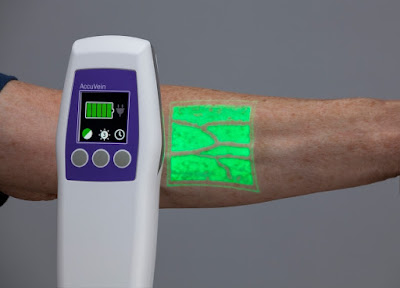Earlier this week, I had one of my periodic MRIs as a cancer survivor – All clear! During the scan, I get a chemical injected partway through called gadolinium, which allows the scanner to pick up blood flow. Since chemotherapy, my veins have been more constricted than most people's, making it difficult to get the IV in. After a couple failed attempts to get a vein by feel, the tech got out a type of vein-finding device I had never seen before:
 |
| AccuVein |
This is a little different from the one that was used on me, but the tech was already flustered enough from the two failed pokes without me pulling a camera out. The device projects a square of light with shadows anywhere there's a vein. As was the case when I got an ultrasound, I started asking questions about how it works, only to be met with shrugs.
It turns out the device uses near-infrared light to scan over the area. Blood vessels contain lots of water, which absorbs in the near-infrared region:
 |
| Wikipedia |
This plot shows the amount of light absorbed by liquid water at different wavelengths. It dips down for the visible spectrum, which is why water appears transparent, but rises quickly on either side. That means the blood vessels will absorb the light put out by the device, instead of reflecting it. It can detect where these gaps in reflection occur, and project an image of the veins on skin.
I've been a cancer patient and survivor for 10 years now, and I'm delighted to keep finding interesting physics in my medical experiences!
No comments:
Post a Comment